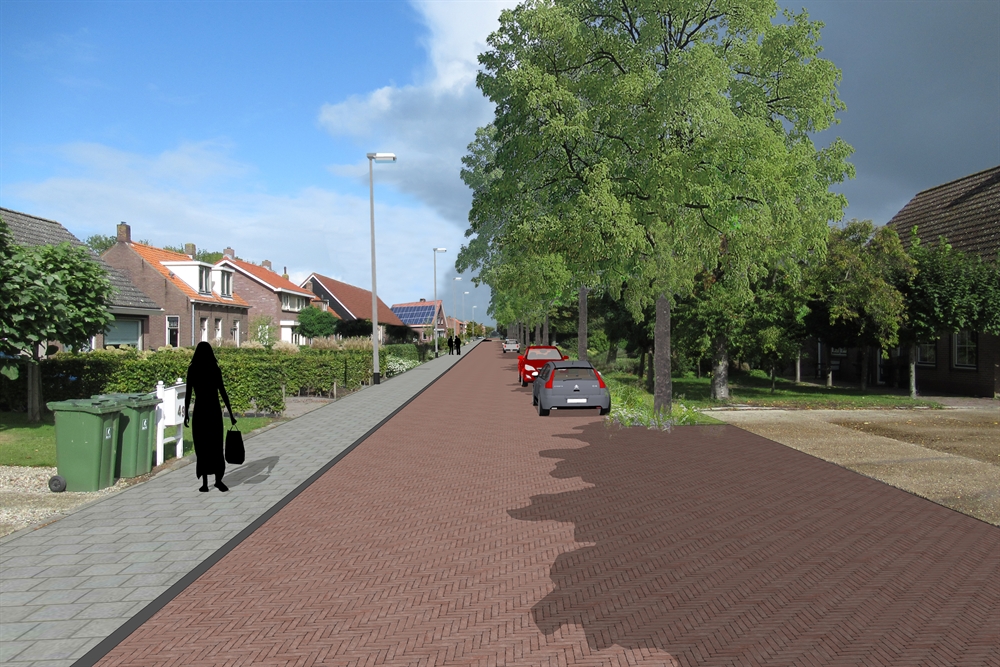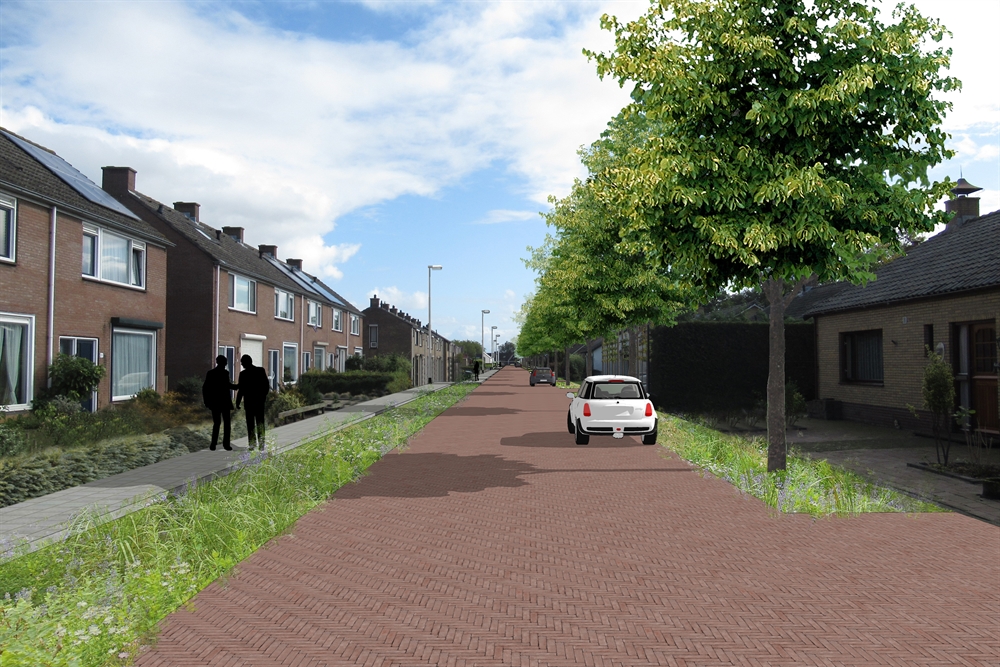Impact project: Nieuwdorp Climate Street
In the village of Nieuwdorp, residents, organisations, and entrepreneurs are collaborating on a new vision to enhance the sustainability and liveability of their village. A component of the vision is the Climate Street project: rendering two streets climate-proof and energy-neutral. Risk dialogues have been conducted to involve residents and other parties in the project.
Why a new village vision?
Nieuwdorp is located adjacent to the Sloegebied, a large port and industrial area. For several decades, the residents of Nieuwdorp have been experiencing various negative effects of this area, such as stench, noise, and heat stress. In addition, the Regenboog primary school is due for renovation, whilst the church is being converted into a community centre. Under the new village vision, the residents, authorities, organisations, and entrepreneurs are pursuing the future sustainability and liveability of the village. The vision encompasses plans for 24 projects. One such project is the Climate Street.
What is the purpose of the dialogue on the Climate Street?
The municipality of Borsele is in charge of the Climate Street, in collaboration with Rothuizen Architects and Urban Planners, HZ University of Applied Sciences, and the Het Nieuwe Samenspel serious game. They are working on the following goals:
- Raising awareness: ensuring that stakeholders appreciate the importance of climate adaptation and the energy transition;
- Collaboration: the municipality is joining forces with residents, authorities, businesses, and organisations;
- Sustainability: two streets will become climate-proof and energy-neutral.
Who is participating in the dialogue?
The main dialogue partners are the residents of the two Climate Streets and the other Nieuwdorp residents. Other partners are local construction companies, installation companies, spatial planners, the Scheldestromen district water board, energy and grid operators, the Regenboog primary school, the village council, and R&B housing corporation.
What has already been accomplished?
In the purview of an efficient dialogue, the collaboration partners have taken the following steps:
- Step 1 Announcement: They introduced the Climate Street to residents, businesses, and organisations, presenting the step-by-step plan and inquiring who was interested in participating in the process;
- Step 2 Dreaming: Together with residents and representatives of the businesses and organisations, they started to “dream” about a climate-proof and energy-neutral village of Nieuwdorp – brainstorming about what such a village could look like;
- Step 3 Concretisation: In several working groups, the partners substantiated and specified the goals and ambitions envisaged;
- Step 4 Evaluation: They shared the outcomes of the procedure with all the participants, discussing what went well and what needed to be or could be improved in future processes.

What results have been achieved thus far?
This dialogue has produced the following results:
- A planning proposal has been set down, featuring impressions for the two streets with several climate adaptation measures;
- An efficient discussion has been conducted and awareness of climate and energy issues has been raised among the villagers.
What will happen next?
The parties will now continue to work on rendering Nieuwdorp climate-proof and energy-neutral. This will involve the following steps:
- The envisaged planning will be elaborated further, and the measures will be assessed for feasibility and effectiveness;
- Alternative routes for freight and farming traffic will be explored and elaborated;
- The combination of underground and above-ground measures will be coordinated with grid managers;
- Regular consultations will be held with local businesses regarding their role in enhancing the sustainability of Nieuwdorp;
- The work on the two streets will be carried out in phases;
- One of the goals is also greening private gardens. Such options will be elaborated further;
- The measures will be translated into a roadmap, which can also be used by the other streets of Nieuwdorp.
Special features
A “competition” at the primary school revealed that children are interested in sustainability issues and would like to contribute ideas. The children were also found to be less hesitant than adults in showing their ideas. For example, some children had made a design for large above-ground water basins.
Lessons to be learned from the dialogue
These are the main lessons to be learned from the “Climate Street dialogue”, regarding the process and the communication:
- Process: during the first meeting, assigning roles to all the participants was difficult. Subsequently, a method was devised to involve everyone nonetheless. So, think about the number of participants beforehand, and consider how to involve everyone;
- Process: earlier than expected, residents wanted to stop brainstorming and proceed to the next step: responding to concrete proposals;
- Communication: prior to the first meeting, unstructured communication had caused confusion. For that reason, the partners subsequently designated a single coordinator and contact person.
In terms of content, these are the most important lessons to be learned
- The Climate Street involves both energy transition and climate adaptation. At the beginning, many participants appeared to have some feeling for the energy transition element but less so for climate adaptation. Many people are less familiar with this theme. That is why both elements have been explained and addressed.
- Broadening the scope is also important. Measures relating to the climate and energy in the immediate environment also touch on other issues, such as road safety, parking, accessibility, and maintenance.
- The proposals in the plan are fairly conservative for the following reasons:
- the Climate Street project is being carried out in an existing residential area. Consequently, you cannot just adapt everything. For example, you need to take account of driveways, entrances, cables, and pipes;
- many residents were open to change but preferred things not to be “taken too far”.
Contact person
Miora Maat
Gemeente Borsele
mmaat-rijk@borsele.nl

